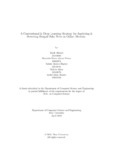| dc.contributor.advisor | Rasel, Annajiat Alim | |
| dc.contributor.advisor | Sadeque, Farig Yousuf | |
| dc.contributor.author | Ahmed, Istiak | |
| dc.contributor.author | Prima, Shanzida Binta Akram | |
| dc.contributor.author | Baptee, Tahsin Anzum | |
| dc.contributor.author | Afroz, Mehrin | |
| dc.contributor.author | Shanto, Ariful Islam | |
| dc.date.accessioned | 2023-09-24T05:43:06Z | |
| dc.date.available | 2023-09-24T05:43:06Z | |
| dc.date.copyright | 2023 | |
| dc.date.issued | 2023-04 | |
| dc.identifier.other | ID 21241066 | |
| dc.identifier.other | ID 19101174 | |
| dc.identifier.other | ID 22141041 | |
| dc.identifier.other | ID 21241078 | |
| dc.identifier.other | ID 19101369 | |
| dc.identifier.uri | http://hdl.handle.net/10361/21171 | |
| dc.description | This thesis is submitted in partial fulfillment of the requirements for the degree of Bachelor of Science in Computer Science and Engineering, 2023. | en_US |
| dc.description | Cataloged from PDF version of thesis. | |
| dc.description | Includes bibliographical references (pages 29-31). | |
| dc.description.abstract | Nowadays, social networking sites like Facebook and Twitter have become an sig-
nificant impact on our lives . We use such sites to remain in touch with one another
and as a source of news to stay informed about current events. As a result, we
frequently see news articles with click-bait headlines from various web portals that
lack authenticity. The majority of these sites that share these sorts of links are used
to manipulate people and spread false propaganda. We intended to utilize both
traditional machine learning algorithms and deep learning algorithms on manually
annotated data-sets to create effective approaches for spotting Bangla fake news
on online media that included about 8,500 pieces of news data. In particular, in
this project, we used classic machine learning algorithms for text classification such
as “Naive Bayes Classifier”, “Support Vector Machines (SVM)”, “K-Nearest Neigh-
bor (KNN)” as well as other classification-based algorithms such as “Decision Tree
(DT)”, “Logistic Regression (LR)”, “Random Forest” and “AdaBoost”. We have
also used deep learning models based on Feed-Forward Neural Networks such as
“Convolutional Neural Network (CNN)” as well as a variety of Recurrent Neural
Networks (RNN) such as “Long-Short Term Memory (LSTM)”, “Gated Recurrent
Unit (GRU)” to detect fake news on online media. To conclude, our research focused
on developing precise strategies for spotting fake news on social media sites. | en_US |
| dc.description.statementofresponsibility | Istiak Ahmed | |
| dc.description.statementofresponsibility | Shanzida Binta Akram Prima | |
| dc.description.statementofresponsibility | Tahsin Anzum Baptee | |
| dc.description.statementofresponsibility | Mehrin Afroz | |
| dc.description.statementofresponsibility | Ariful Islam Shanto | |
| dc.format.extent | 31 pages | |
| dc.language.iso | en | en_US |
| dc.publisher | Brac University | en_US |
| dc.rights | Brac University theses are protected by copyright. They may be viewed from this source for any purpose, but reproduction or distribution in any format is prohibited without written permission. | |
| dc.subject | Conventional machine learning models | en_US |
| dc.subject | Deep learning models | en_US |
| dc.subject | Classic machine learning algorithms | en_US |
| dc.subject | Feed-forward neural networks | en_US |
| dc.subject | Recurrent Neural Networks (RNN) | en_US |
| dc.subject.lcsh | Machine learning | |
| dc.subject.lcsh | Cognitive learning theory | |
| dc.subject.lcsh | Neural networks (Computer science) | |
| dc.title | A conventional & deep learning strategy for analyzing & detecting Bengali fake news in online medium | en_US |
| dc.type | Thesis | en_US |
| dc.contributor.department | Department of Computer Science and Engineering, Brac University | |
| dc.description.degree | B. Computer Science and Engineering | |

